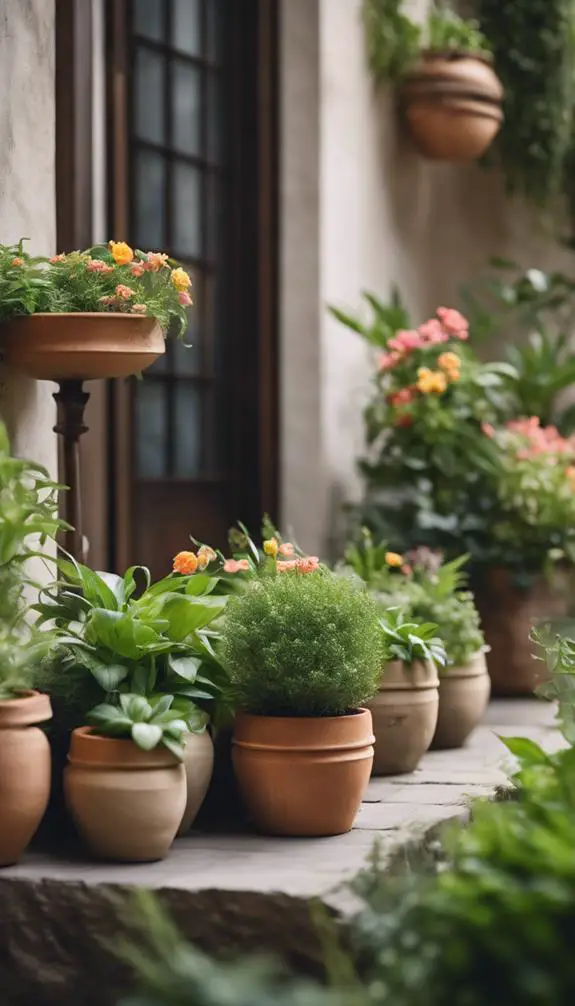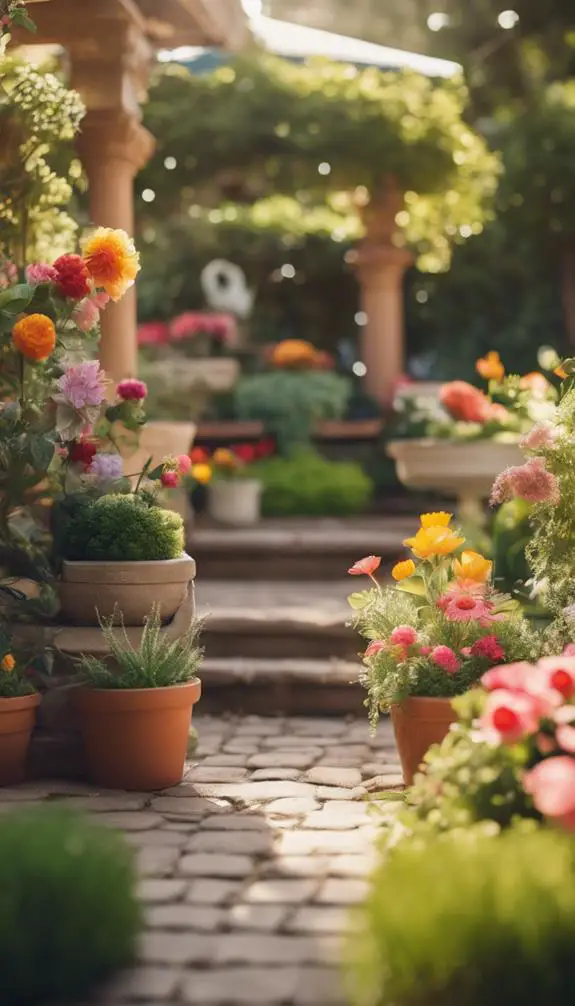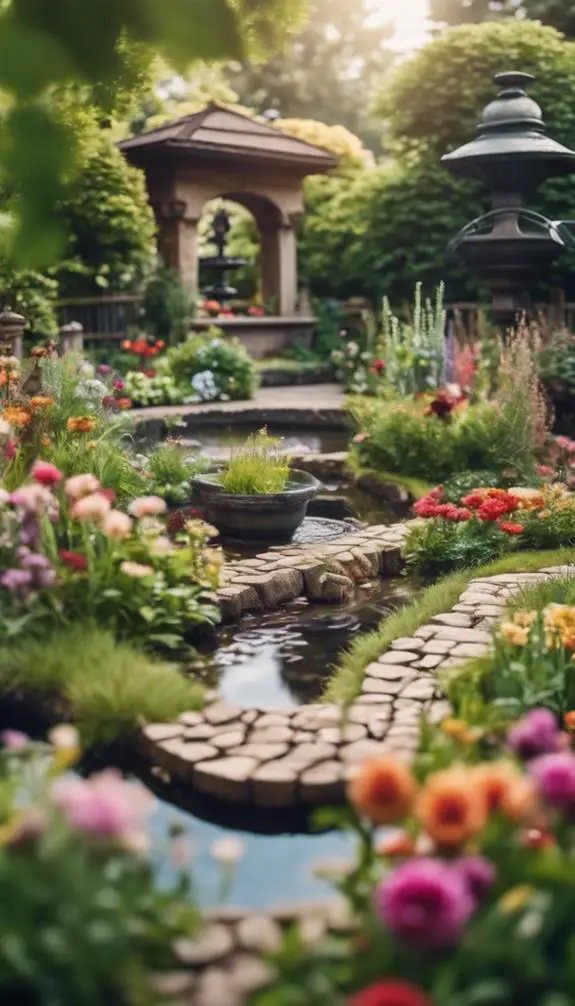As you step into the world of gardening, you're likely enthusiastic to transform your small outdoor space into a serene oasis. But where do you start? Begin by taking stock of your yard's unique challenges and opportunities. Take note of the areas that receive full sun or shade, and consider the direction of the wind. What style of garden resonates with you – modern, traditional, or whimsical? Answering these questions will lay the groundwork for a successful small garden layout that not only thrives in a compact space but also reflects your personal taste. Now, let's explore the essential elements to incorporate into your design…
Summary
- Assess the outdoor space, considering obstacles, spatial constraints, and existing features to determine the ideal layout for your small garden.
- Define your garden style and purpose to guide design decisions and ensure a cohesive, beautiful space that meets your needs.
- Select plants that thrive in compact spaces, considering their specific needs, and choose a soil type that supports their growth.
- Create a garden layout that incorporates vertical gardening, pathways, and decorative features, maximizing space and visual appeal.
- Test and amend your soil to ensure it provides the necessary nutrients and structure for your plants to thrive.
Assessing Your Outdoor Space

Since you're about to design a small garden, vitally, you must evaluate your outdoor space carefully, as this will substantially impact the overall aesthetic and functionality of your garden.
Take note of outdoor obstacles such as slopes, shade, and wind direction, which can affect plant growth and accessibility.
Assess the spatial constraints of your yard, including the dimensions, shape, and orientation.
Identify any existing features like trees, fences, or slopes that may influence your design.
Measure the distance between structures, such as your house, garage, or neighboring buildings, to determine the ideal layout.
Setting Garden Goals and Themes

You'll need to define your garden style, whether it's modern, traditional, or a mix, to guide your design decisions.
Identify the purpose of your garden, such as growing vegetables, entertaining, or relaxation, to determine the necessary features and layout.
Define Your Garden Style
What kind of ambiance do you want to create in your small garden? Do you envision a serene retreat, a vibrant party spot, or a whimsical oasis?
Defining your garden style is vital to creating a space that reflects your personality and meets your needs. Consider your garden personality: are you a minimalist, a maximalist, or somewhere in between?
Look for design inspiration online, in magazines, or by visiting gardens that resonate with you. Identify the elements that appeal to you, such as color schemes, textures, and features like water or stone.
This will help you develop a clear vision for your garden, guiding your design decisions and ensuring a cohesive, beautiful space that truly reflects you.
Identify Garden Purpose
As you solidify your garden style, it's time to pinpoint the purpose of your small garden.
This involves setting clear garden ambitions that align with your personal priorities. Ask yourself: What do I want to achieve with my garden? Is it a space for relaxation, entertainment, or food production? Do you want to create a habitat for wildlife or showcase ornamental plants?
Clarify your goals to determine the garden's primary function. This will help you allocate space and resources effectively. Consider your lifestyle, available time, and maintenance capabilities to guarantee your garden ambitions are realistic and achievable.
Set Realistic Expectations
Setting realistic expectations is crucial to avoiding frustration and ensuring your small garden remains a source of joy.
As a beginner gardener, key to recognize your limitations and capabilities. Unrealistic dreams can lead to garden mistakes, which can be costly and demotivating.
Start by evaluating your available time, budget, and climate. Be honest about the amount of maintenance you're willing to commit to.
Consider your garden's purpose and prioritize your goals. Are you looking to grow vegetables, herbs, or flowers? Do you want a low-maintenance or a vibrant, colorful garden?
Choosing a Garden Style

With your small garden's parameters in mind, you're now poised to plunge into the domain of style, where creativity meets functionality.
This is where you infuse your personality into the garden's design. You can draw garden inspiration from various sources, such as nature, art, or architecture.
Consider what evokes a sense of serenity or excitement in you. Do you prefer structured, symmetrical layouts or free-flowing, organic shapes?
Think about how you want to use your garden – will it be a quiet retreat or an entertainment space?
Your personal expression will shine through in the style you choose, so take your time and explore different options.
Understanding Sunlight and Shade

When planning your small garden layout, you'll need to ponder the sunlight hour requirements of your plants, as most vegetables and fruits need at least six hours of direct sunlight per day.
However, if your garden receives partial shade, you can still grow shade-tolerant plants like lettuce, spinach, or herbs.
Sunlight Hour Requirements
As you assess your small garden's potential, understanding sunlight hour requirements becomes crucial, since different plants thrive in varying levels of sunlight and shade.
You'll need to determine the specific sunlight needs of each plant you want to grow. Some plants require full sun, meaning six hours or more of direct sunlight, while others prefer partial sun, which is four to six hours.
Morning sun, especially in warmer climates, can be intense, so consider plants that tolerate high temperatures. Afternoon shade, on the other hand, provides relief from the intense sun, making it ideal for plants that prefer cooler conditions.
Shade Tolerant Plant Options
You've determined the sunlight hour requirements for your small garden, and now it's time to select plants that thrive in shade or partial shade.
When choosing shade-tolerant plants, consider shade loving flowers like impatiens, coleus, or begonias, which add vibrant colors to your garden.
For ground cover alternatives, opt for low-maintenance options like creeping thyme, vinca minor, or pachysandra, which suppress weeds and require minimal care.
These plants not only tolerate shade but also provide texture, contrast, and interest to your garden. By incorporating these shade-tolerant plants into your design, you'll create a visually appealing and functional small garden that thrives in low-light conditions.
Selecting the Right Plants

Harmony in a small garden layout begins with selecting the right plants, as a thoughtful choice can transform a cramped space into a serene oasis.
You'll want to ponder plants that thrive in compact spaces, such as dwarf or compact varieties. Avoid beginner mistakes like overcrowding, which can lead to disease and pest issues.
Instead, choose plants with varying heights, textures, and bloom times to create visual interest. Ponder plants that serve multiple purposes, like herbs that provide flavor and fragrance.
Make a list of your must-haves, and research each plant's specific needs to verify compatibility. By doing so, you'll create a cohesive and thriving plant selection that elevates your small garden layout.
Considering Soil Type and Quality

You'll need to assess your soil's pH level, nutrient content, and structure to determine its type and quality, as this will impact your plant selection and growth.
To do this, you'll want to conduct a soil test, which will provide essential data on your soil's composition and fertility.
Soil Testing Essentials
Before breaking ground on your small garden, it's vital to understand the soil you're working with, as this foundation will either make or break your garden's success.
You'll need to test your soil to determine its pH level, which affects nutrient availability, and its composition, comprising sand, silt, and clay. A soil test kit or laboratory analysis will provide accurate results.
Ideal soil pH ranges from 6.0 to 7.0, with most vegetables and flowers thriving between 6.5 and 7.0.
Analyze your soil composition to identify potential issues, such as poor drainage or waterlogging. With this knowledge, you'll be able to choose the right plants and make informed decisions about amendments, ensuring a thriving and productive small garden.
Soil Amendment Options
Nearly every small garden benefits from some form of soil amendment, as even the best testing and planning can't compensate for inherent soil deficiencies.
You've tested your soil, and now it's time to address any imbalances. Consider incorporating organic matter like compost tea or worm castings to enhance soil structure and fertility.
Compost tea, a liquid solution rich in beneficial microbes, can be brewed on-site using your compost pile. Worm castings, the nutrient-rich byproduct of worm composting, provide slow-release nutrients.
Both amendments promote healthy microbial activity, which in turn supports plant growth and resilience. By choosing the right soil amendment for your garden, you'll create a thriving ecosystem that rewards your efforts with vibrant, healthy plants.
Creating a Garden Layout Plan
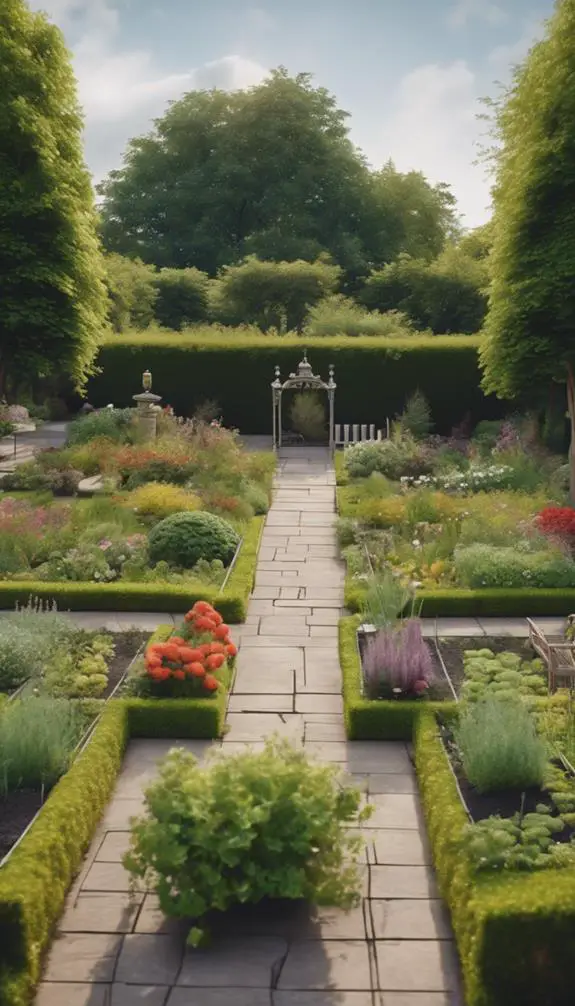
With your small garden's dimensions and features in mind, start by sketching its outline on graph paper, using a scale of one quarter inch or one half centimeter per foot or meter to certify accuracy.
This will be your garden blueprint. Mark the location of any fixed features, such as a patio or shed, as well as the direction of sunlight and wind.
Next, divide your garden into sections or zones, based on the type of plants you want to grow and their specific needs.
Consider the mature size of each plant when planning their placement, ensuring enough space for growth and air circulation. This detailed plan will serve as a guide for your plant placement, allowing you to visualize and refine your garden's layout before breaking ground.
Working With Small Garden Shapes
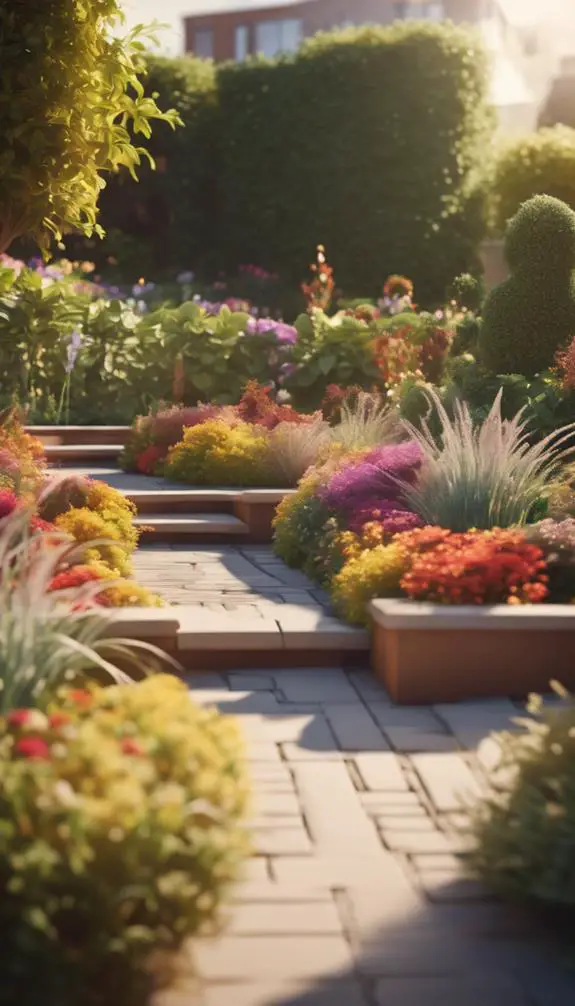
Your small garden's shape, whether rectangular, triangular, circular, or irregular, plays a significant role in determining its overall aesthetic and functionality.
When working with square plots, you can divide the space into four equal sections, creating a sense of symmetry and balance.
For angular corners, consider using curved borders or rounded planters to soften the edges and create a more fluid design.
Triangular plots can be challenging, but using a central focal point, like a statement plant or statue, can draw the eye inward and create visual interest.
Regardless of your garden's shape, understanding its unique characteristics will help you design a functional and beautiful space that maximizes its potential.
Using Vertical Gardening Techniques

In a small garden, every inch counts, and using vertical gardening techniques is a great way to maximize space.
You can use vertical planters to grow vining plants like peas, beans, or flowers, which will spread upwards, making the most of your garden's vertical space.
Another option is to create a living wall, where plants are attached to a trellis or a wall-mounted planter, adding depth and texture to your garden.
This technique also helps to provide shade, reduce wind, and create a sense of enclosure.
Incorporating Pathways and Patios
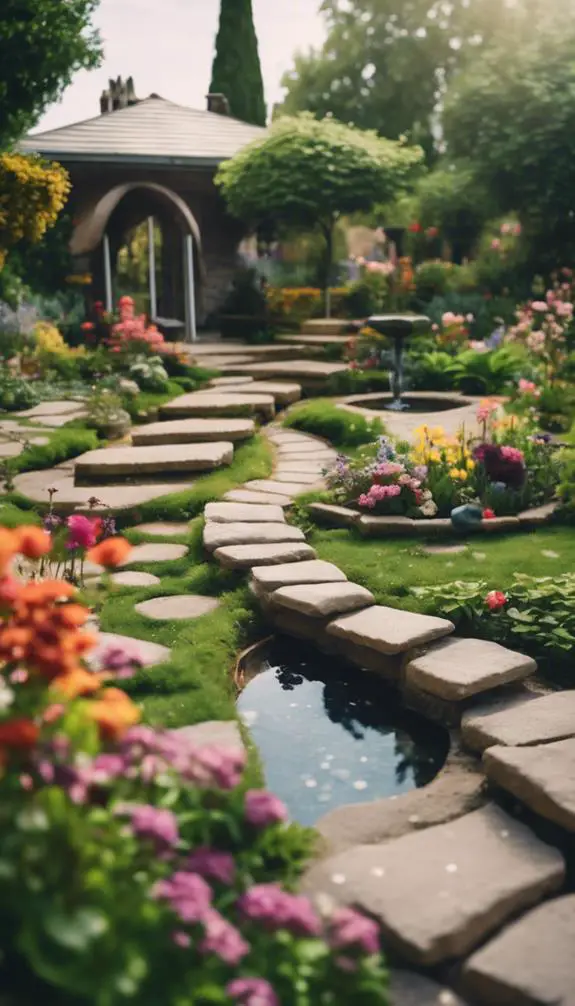
As you begin to visualize your small garden's layout, incorporating pathways and patios becomes a crucial element to ponder.
Pathways serve as a guide through your garden, connecting different areas while also adding visual appeal. When selecting pathway materials, consider durability, maintenance, and aesthetics.
Gravel, brick, and stone are popular options, each offering unique benefits. For instance, gravel allows for good drainage, while brick provides a classic, timeless look.
Patios, on the other hand, provide a dedicated space for relaxation and entertainment. Consider patio seating that's both functional and stylish, such as built-in benches or outdoor sofas.
Adding Decorative Garden Features
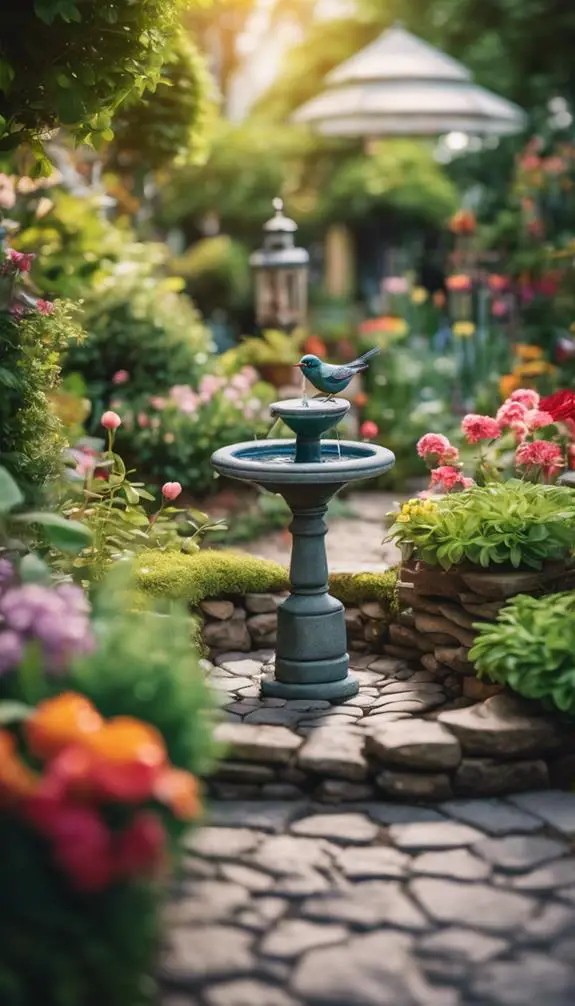
Enhancing your small garden's visual appeal and functionality involves thoughtfully adding decorative garden features that complement its layout.
You can incorporate garden ornaments, such as statues, bird baths, or sundials, to add visual interest and personality to your space. Consider the style and theme of your garden when selecting ornaments to certify they blend harmoniously with the surroundings.
Water features, like mini fountains or birdbaths, can also create a soothing ambiance and attract wildlife. Strategically place these features to create focal points, define different areas, or conceal unsightly elements.
Maximizing Storage and Function

You've carefully selected decorative garden features to elevate your small garden's visual appeal, but now it's time to think about functionality.
To maximize storage and function, incorporate multi-functional elements into your design. Consider garden benches with hidden compartments underneath the seats or backs, providing a discreet place to store gardening tools, seeds, or other supplies.
You can also install vertical planters or trellises that double as storage units for small items like pruning shears or gloves. By cleverly integrating storage into your design, you'll create a more efficient and organized gardening space that allows you to focus on nurturing your plants.
Maintaining Your Small Garden

Throughout your small garden's lifespan, regular upkeep is crucial to ensuring its continued health and beauty.
You'll need to stay on top of tasks like pruning, weeding, and fertilizing to maintain its peak condition. To conserve water, install a drip irrigation system or soaker hose, and water plants deeply but infrequently to encourage deep root growth.
Keep track of your garden's progress by maintaining a garden journal, where you can record observations, note weather patterns, and plan for future seasons.
Regularly inspect your garden for signs of pests or diseases, and take action promptly to prevent their spread. By staying proactive and keeping a close eye on your garden, you'll be able to enjoy its beauty and bounty for years to come.
FAQs
How Do I Handle Pests and Diseases in My Small Garden?
You'll effectively manage pests and diseases by implementing integrated pest control methods, combining organic remedies like neem oil and diatomaceous earth with physical barriers, crop rotation, and biological controls to create a resilient and thriving garden ecosystem.
What Is the Best Time to Water My Plants in the Morning or Evening?
When you water, you're managing water stress; morning's the best time, as it allows plants to absorb water throughout the day, whereas evening watering can encourage fungal growth. Check soil moisture daily to adjust your schedule accordingly.
Can I Grow Vegetables in a Garden With Partial Shade?
You can grow vegetables in partial shade, but guarantee you choose shade-tolerant varieties and provide at least 4-6 hours of direct sunlight. Some veggies, like leafy greens, can thrive with indirect sunlight, but others, like tomatoes, require more intense sunlight hours.
How Often Should I Fertilize My Plants in a Small Garden?
You'll want to establish a fertilizer schedule based on your soil quality; for most plants, fertilize every 4-6 weeks during the growing season, but adjust frequency according to soil type, plant needs, and manufacturer instructions.
Can I Use Artificial Turf in a Small Garden Instead of Real Grass?
You're considering artificial turf, which offers low Turf maintenance and Artificial benefits like consistent appearance and water conservation, but weigh these advantages against potential drawbacks, such as heat absorption and limited environmental benefits, before making a decision.
Conclusion
You've successfully navigated the process of designing a small garden layout tailored to your needs. By evaluating your outdoor space, defining your garden style, and selecting suitable plants, you've created a functional and visually appealing area. Remember to incorporate pathways, patios, and decorative features to maximize space and enhance aesthetics. Now, maintain your garden by regularly pruning, watering, and monitoring its progress to verify a thriving oasis that brings you joy and serenity.


